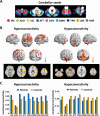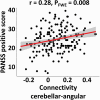Cerebellar Functional Dysconnectivity in Drug-Naïve Patients With First-Episode Schizophrenia
- PMID: 36200880
- PMCID: PMC10016395
- DOI: 10.1093/schbul/sbac121
Cerebellar Functional Dysconnectivity in Drug-Naïve Patients With First-Episode Schizophrenia
Abstract
Background: Cerebellar functional dysconnectivity has long been implicated in schizophrenia. However, the detailed dysconnectivity pattern and its underlying biological mechanisms have not been well-charted. This study aimed to conduct an in-depth characterization of cerebellar dysconnectivity maps in early schizophrenia.
Study design: Resting-state fMRI data were processed from 196 drug-naïve patients with first-episode schizophrenia and 167 demographically matched healthy controls. The cerebellum was parcellated into nine functional systems based on a state-of-the-art atlas, and seed-based connectivity for each cerebellar system was examined. The observed connectivity alterations were further associated with schizophrenia risk gene expressions using data from the Allen Human Brain Atlas.
Study results: Overall, we observed significantly increased cerebellar connectivity with the sensorimotor cortex, default-mode regions, ventral part of visual cortex, insula, and striatum. In contrast, decreased connectivity was shown chiefly within the cerebellum, and between the cerebellum and the lateral prefrontal cortex, temporal lobe, and dorsal visual areas. Such dysconnectivity pattern was statistically similar across seeds, with no significant group by seed interactions identified. Moreover, connectivity strengths of hypoconnected but not hyperconnected regions were significantly correlated with schizophrenia risk gene expressions, suggesting potential genetic underpinnings for the observed hypoconnectivity.
Conclusions: These findings suggest a common bidirectional dysconnectivity pattern across different cerebellar subsystems, and imply that such bidirectional alterations may relate to different biological mechanisms.
Keywords: cerebellum; genetic risk; hyperconnectivity; hypoconnectivity; schizophrenia.
© The Author(s) 2022. Published by Oxford University Press on behalf of the Maryland Psychiatric Research Center. All rights reserved. For permissions, please email: journals.permissions@oup.com.
Figures



Similar articles
-
Disrupted functional connectivity of the cerebellum with default mode and frontoparietal networks in young adults with major depressive disorder.Psychiatry Res. 2023 Jun;324:115192. doi: 10.1016/j.psychres.2023.115192. Epub 2023 Apr 8. Psychiatry Res. 2023. PMID: 37054552
-
Cerebellar-cortical dysconnectivity in resting-state associated with sensorimotor tasks in schizophrenia.Hum Brain Mapp. 2020 Aug 1;41(11):3119-3132. doi: 10.1002/hbm.25002. Epub 2020 Apr 6. Hum Brain Mapp. 2020. PMID: 32250008 Free PMC article.
-
Altered resting-state functional connectivity of the cerebellum in schizophrenia.Brain Imaging Behav. 2018 Apr;12(2):383-389. doi: 10.1007/s11682-017-9704-0. Brain Imaging Behav. 2018. PMID: 28293803 Free PMC article.
-
Resting-state networks in schizophrenia.Curr Top Med Chem. 2012;12(21):2404-14. doi: 10.2174/156802612805289863. Curr Top Med Chem. 2012. PMID: 23279179 Review.
-
Cerebellar structural and functional abnormalities in first-episode and drug-naive patients with schizophrenia: A meta-analysis.Psychiatry Res Neuroimaging. 2019 Jan 30;283:24-33. doi: 10.1016/j.pscychresns.2018.11.009. Epub 2018 Nov 22. Psychiatry Res Neuroimaging. 2019. PMID: 30500474 Review.
Cited by
-
Cerebellar stimulation in schizophrenia: A systematic review of the evidence and an overview of the methods.Front Psychiatry. 2022 Dec 22;13:1069488. doi: 10.3389/fpsyt.2022.1069488. eCollection 2022. Front Psychiatry. 2022. PMID: 36620688 Free PMC article.
-
Editorial: Cerebellar structure and function in psychotic disorders: from mechanisms to clinics.Front Psychiatry. 2023 Dec 7;14:1344882. doi: 10.3389/fpsyt.2023.1344882. eCollection 2023. Front Psychiatry. 2023. PMID: 38146281 Free PMC article. No abstract available.
-
The immediate alteration of cerebellar Glx/GABA and cerebello-thalamo-cortical connectivity in patients with schizophrenia after cerebellar TMS.Schizophrenia (Heidelb). 2025 Feb 4;11(1):12. doi: 10.1038/s41537-025-00563-8. Schizophrenia (Heidelb). 2025. PMID: 39905027 Free PMC article.
-
Functional Connectivity-Based Searchlight Multivariate Pattern Analysis for Discriminating Schizophrenia Patients and Predicting Clinical Variables.Schizophr Bull. 2024 Dec 20;51(1):108-119. doi: 10.1093/schbul/sbae084. Schizophr Bull. 2024. PMID: 38819252 Free PMC article.
-
Imaging Biomarker Studies of Antipsychotic-Naïve First-Episode Schizophrenia in China: Progress and Future Directions.Schizophr Bull. 2025 Mar 14;51(2):379-391. doi: 10.1093/schbul/sbaf002. Schizophr Bull. 2025. PMID: 39841545 Review.
References
-
- Ding Y, Ou Y, Pan P, et al. . Cerebellar structural and functional abnormalities in first-episode and drug-naive patients with schizophrenia: a meta-analysis. Psychiatry Res Neuroimag. 2019;283:24–33. - PubMed
-
- Andreasen NC, Paradiso S, O’Leary DS.. “Cognitive dysmetria” as an integrative theory of schizophrenia: a dysfunction in cortical-subcortical-cerebellar circuitry? Schizophr Bull. 1998;24(2):203–218. - PubMed
-
- Guo W, Zhang F, Liu F, et al. . Cerebellar abnormalities in first-episode, drug-naive schizophrenia at rest. Psychiatry Res Neuroimag. 2018;276:73–79. - PubMed
Publication types
MeSH terms
LinkOut - more resources
Full Text Sources
Medical

